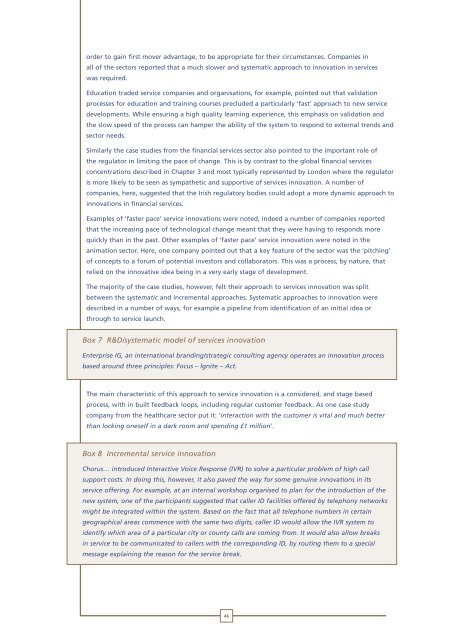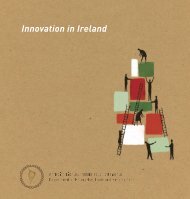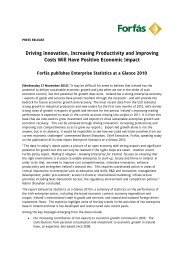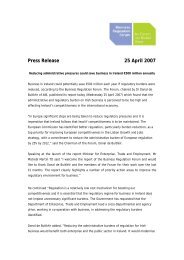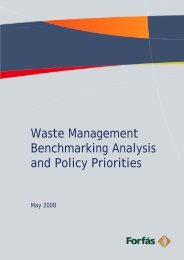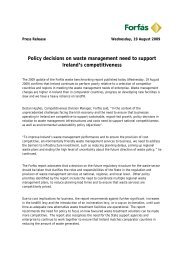Services Innovation in Ireland - Options for ... - Europe INNOVA
Services Innovation in Ireland - Options for ... - Europe INNOVA
Services Innovation in Ireland - Options for ... - Europe INNOVA
Create successful ePaper yourself
Turn your PDF publications into a flip-book with our unique Google optimized e-Paper software.
order to ga<strong>in</strong> first mover advantage, to be appropriate <strong>for</strong> their circumstances. Companies <strong>in</strong><br />
all of the sectors reported that a much slower and systematic approach to <strong>in</strong>novation <strong>in</strong> services<br />
was required.<br />
Education traded service companies and organisations, <strong>for</strong> example, po<strong>in</strong>ted out that validation<br />
processes <strong>for</strong> education and tra<strong>in</strong><strong>in</strong>g courses precluded a particularly ‘fast’ approach to new service<br />
developments. While ensur<strong>in</strong>g a high quality learn<strong>in</strong>g experience, this emphasis on validation and<br />
the slow speed of the process can hamper the ability of the system to respond to external trends and<br />
sector needs.<br />
Similarly the case studies from the f<strong>in</strong>ancial services sector also po<strong>in</strong>ted to the important role of<br />
the regulator <strong>in</strong> limit<strong>in</strong>g the pace of change. This is by contrast to the global f<strong>in</strong>ancial services<br />
concentrations described <strong>in</strong> Chapter 3 and most typically represented by London where the regulator<br />
is more likely to be seen as sympathetic and supportive of services <strong>in</strong>novation. A number of<br />
companies, here, suggested that the Irish regulatory bodies could adopt a more dynamic approach to<br />
<strong>in</strong>novations <strong>in</strong> f<strong>in</strong>ancial services.<br />
Examples of ‘faster pace’ service <strong>in</strong>novations were noted, <strong>in</strong>deed a number of companies reported<br />
that the <strong>in</strong>creas<strong>in</strong>g pace of technological change meant that they were hav<strong>in</strong>g to responds more<br />
quickly than <strong>in</strong> the past. Other examples of ‘faster pace’ service <strong>in</strong>novation were noted <strong>in</strong> the<br />
animation sector. Here, one company po<strong>in</strong>ted out that a key feature of the sector was the ‘pitch<strong>in</strong>g’<br />
of concepts to a <strong>for</strong>um of potential <strong>in</strong>vestors and collaborators. This was a process, by nature, that<br />
relied on the <strong>in</strong>novative idea be<strong>in</strong>g <strong>in</strong> a very early stage of development.<br />
The majority of the case studies, however, felt their approach to services <strong>in</strong>novation was split<br />
between the systematic and <strong>in</strong>cremental approaches. Systematic approaches to <strong>in</strong>novation were<br />
described <strong>in</strong> a number of ways, <strong>for</strong> example a pipel<strong>in</strong>e from identification of an <strong>in</strong>itial idea or<br />
through to service launch.<br />
Box 7 R&D/systematic model of services <strong>in</strong>novation<br />
Enterprise IG, an <strong>in</strong>ternational brand<strong>in</strong>g/strategic consult<strong>in</strong>g agency operates an <strong>in</strong>novation process<br />
based around three pr<strong>in</strong>ciples: Focus – Ignite – Act.<br />
The ma<strong>in</strong> characteristic of this approach to service <strong>in</strong>novation is a considered, and stage based<br />
process, with <strong>in</strong> built feedback loops, <strong>in</strong>clud<strong>in</strong>g regular customer feedback. As one case study<br />
company from the healthcare sector put it: ‘<strong>in</strong>teraction with the customer is vital and much better<br />
than lock<strong>in</strong>g oneself <strong>in</strong> a dark room and spend<strong>in</strong>g £1 million’.<br />
Box 8 Incremental service <strong>in</strong>novation<br />
Chorus… <strong>in</strong>troduced Interactive Voice Response (IVR) to solve a particular problem of high call<br />
support costs. In do<strong>in</strong>g this, however, it also paved the way <strong>for</strong> some genu<strong>in</strong>e <strong>in</strong>novations <strong>in</strong> its<br />
service offer<strong>in</strong>g. For example, at an <strong>in</strong>ternal workshop organised to plan <strong>for</strong> the <strong>in</strong>troduction of the<br />
new system, one of the participants suggested that caller ID facilities offered by telephony networks<br />
might be <strong>in</strong>tegrated with<strong>in</strong> the system. Based on the fact that all telephone numbers <strong>in</strong> certa<strong>in</strong><br />
geographical areas commence with the same two digits, caller ID would allow the IVR system to<br />
identify which area of a particular city or county calls are com<strong>in</strong>g from. It would also allow breaks<br />
<strong>in</strong> service to be communicated to callers with the correspond<strong>in</strong>g ID, by rout<strong>in</strong>g them to a special<br />
message expla<strong>in</strong><strong>in</strong>g the reason <strong>for</strong> the service break.<br />
46


